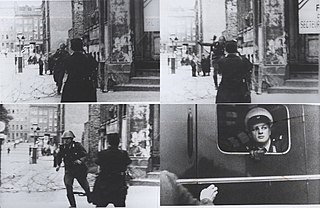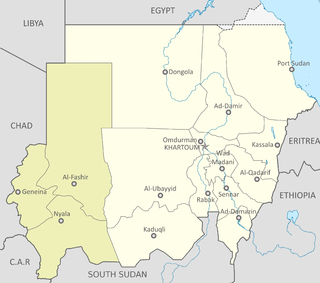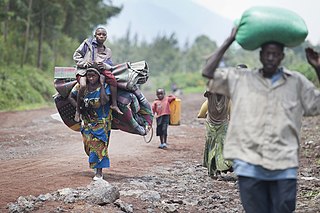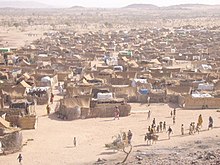The United Nations High Commissioner for Refugees (UNHCR) is a United Nations agency mandated to aid and protect refugees, forcibly displaced communities, and stateless people, and to assist in their voluntary repatriation, local integration or resettlement to a third country. It is headquartered in Geneva, Switzerland, with over 18,879 staff working in 138 countries as of 2020.

A refugee, conventionally speaking, is a person who has lost the protection of their country of origin and who cannot or is unwilling to return there due to well-founded fear of persecution. Such a person may be called an asylum seeker until granted refugee status by the contracting state or the United Nations High Commissioner for Refugees (UNHCR) if they formally make a claim for asylum.

An internally displaced person (IDP) is someone who is forced to leave their home but who remains within their country's borders. They are often referred to as refugees, although they do not fall within the legal definitions of a refugee.
There are tens of thousands of Sudanese refugees in Egypt, most of them seeking refuge from ongoing military conflicts in their home country of Sudan. Their official status as refugees is highly disputed, and they have been subject to racial discrimination and police violence.

Mediation of the Chadian-Sudanese conflict began shortly after the government of Chad declared an "état de belligérance", or 'state of belligerency' with Sudan. on December 23, 2005. The BBC translated "belligérance" as "war".

Refugees of Iraq are Iraqi nationals who have fled Iraq due to war or persecution. Throughout 1980 until 2017, there were a large number of refugees fleeing Iraq and settling throughout the world, peaking with the Iraq War and continued until the end of the most recent War in Iraq (2013–2017). Precipitated by a series of conflicts including the Kurdish rebellions during the Iran–Iraq War, Iraq's Invasion of Kuwait (1990) and the Gulf War (1991), the subsequent sanctions against Iraq (1991–2003), culminating in the Iraq War and the subsequent War in Iraq (2013–2017), millions were forced by insecurity to flee their homes in Iraq. Like the majority of refugees worldwide, Iraqi refugees established themselves in urban areas in other countries rather than in refugee camps. In April 2007, there was an estimate of over four million Iraqi refugees around the world, including 1.9 million in Iraq, 2 million in neighboring Middle East countries, and around 200,000 in countries outside the Middle East. The United Nations High Commissioner for Refugees (UNHCR) has led the humanitarian efforts for Iraqi refugees. The Iraqi displacement of several million was the largest in the Middle East at the time, and was even larger than the number of Palestinians who were displaced in 1948 during the creation of the state of Israel.
Bruno Geddo is an Italian national, born in Novara in 1959. He has served with the United Nations High Commissioner for Refugees (UNHCR) for over 30 years in Sub-Saharan Africa, North Africa and the Middle East.
An urban refugee is a refugee who decided or was obliged to settle in an urban area rather than in a refugee camp in the country or territory where the person fled to. More than 60% of the world's refugee population and 80% of internally displaced persons (IDP) under UNHCR mandate live in urban environments. In 2009, their number was around 5.5 million people. "Urban refugee" is not a recognized legal term in the 1951 Convention relating to the Status of Refugees. However, the UNHCR has adopted a 'Policy on Refugee Protection and Solutions in Urban Areas' in 2009.
Azerbaijan has a large number of internally displaced people and refugees, mostly as a result of the Nagorno-Karabakh conflict. The First Nagorno-Karabakh war led to the displacement of approximately 750,000 Azerbaijanis. This figure includes around 500,000 people from Nagorno-Karabakh and the previously occupied surrounding regions, in addition to 186,000 from Armenia.

Sudanese refugees in Israel refers to citizens of Sudan who have sought refuge in Israel due to military conflict at home, and to those who moved there illegally as migrant workers. In 2008, there were 4,000 Sudanese in Israel, 1,200 from Darfur and the remainder Christians from South Sudan. The majority entered through the Israeli-Egypt border. Most live in Tel Aviv, Arad, Eilat and Bnei Brak.
The number of people who are currently displaced inside Iraq is estimated to be 3 million, almost one out of every ten Iraqis. This figure is cumulative and represents both those displaced before and after the 2003 US-led invasion. Displacement in Iraq is "chronic and complex:" since the 1960s Iraq has produced the largest population of Internally Displaced Persons (IDPs) and refugees of any state in the Middle East.

The Kampala Convention is a treaty of the African Union (AU) that addresses internal displacement caused by armed conflict, natural disasters and large-scale development projects in Africa.
By January 2011 the United Nations High Commissioner for Refugees (UNHCR) estimated that there are 262,900 Sudanese refugees in Chad. The majority of them left Sudan escaping from the violence of the ongoing Darfur crisis, which began in 2003. UNHCR has given the Sudanese refugees shelter in 12 different camps situated along the Chad–Sudan border. The most pressing issues UNHCR has to deal with in the refugee camps in Chad are related to insecurity in the camps,, malnutrition, access to water, HIV and AIDS, and education.
Qatar Charity is a humanitarian and development non-governmental organization in the Middle East. It was founded in 1992 in response to the thousands of children who were made orphans by the Afghanistan war and while orphans still remain a priority cause in the organization's work with more than 150,000 sponsored orphans, it has now expanded its fields of action to include six humanitarian fields and seven development fields.
International Organization for Migration (IOM) Mission in Ukraine is an official representative office of the International Organization for Migration in the country and is located in its capital city Kyiv.
A refugee crisis can refer to difficulties and dangerous situations in the reception of large groups of forcibly displaced persons. These could be either internally displaced, refugees, asylum seekers or any other huge groups of migrants.
The Mustapha Mahmoud Park Massacre denotes a 2005 incident in Cairo, in which dozens of Sudanese asylum seekers were killed. The civil wars in Sudan that have been taking place on and off since 1955, the subsequent destabilization and economic collapse caused by the country's infrastructure and economy, and the fighting in Darfur (2003), forced millions of Sudanese civilians to flee their homes and cities. Many of them arrived in Egypt, the neighboring country.

The Darfur genocide is the systematic killing of ethnic Darfuri people which has occurred during the ongoing conflict in western Sudan. It has become known as the first genocide of the 21st century. The genocide, which is being carried out against the Fur, Masalit and Zaghawa ethnic groups, has led the International Criminal Court (ICC) to indict several people for crimes against humanity, rape, forced transfer and torture. An estimated 200,000 people were killed between 2003 and 2005.
Usumain Tukuny Baraka is a Sudanese activist and asylum seeker living in Israel. He is a leader of Israel's asylum-seeking community and the first Darfuri refugee to graduate from a Hebrew-language program in an Israeli university.
Ethiopian refugees in Sudan are individuals from Ethiopia who have sought asylum in Sudan due to various reasons, including the two-year civil war in the Tigray region and other challenging circumstances in Ethiopia.







